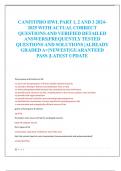CANFITPRO HWL PART 1, 2 AND 3 2024-
2025 WITH ACTUAL CORRECT
QUESTIONS AND VERIFIED DETAILED
ANSWERS|FREQUENTLY TESTED
QUESTIONS AND SOLUTIONS |ALREADY
GRADED A+|NEWEST|GUARANTEED
PASS |LATEST UPDATE
The purpose and function of fat
-to aid in the transportation of the fat soluble vitamins (A,D,E,K)
-to provide a feeling of fullness and satisfaction from a meal
-to make eating pleasurable because they contribute to taste and texture
-to provide tissue structure to cells, including those in the nervous system, heart and liver
-to provide vital organ protection
-to provide thermal insulation and controlling body temperature
-to facilitate the transmission of nerve impulses by insulating nerve cells
-a concentrated and energetically efficient source of fuel
grams of fat equal to 9 calories
1g of fat
the body's main source of fuel for prolonged exercise
body fat (adipose tissue)
the 4 types of fat
unsaturated, saturated, cholesterol, trans fatty acid
fats that remain liquid at room temperature (monounsaturated and polyunsaturated)
unsaturated fats
1|Page
,a fat containing only one double bond between carbons; the key fatty acid is oleic acid (OA). It may help
lower blood cholesterol.
monosaturated fatty acid (MUFA)
fatty acid with two or more double bonds; the 2 essential fatty acids (EFA) that the body cannot produce
and must get from the diet (alpha-linolenic acid, ALA and linolenic acid, LA)
polyunsaturated fatty acids (PUFA)
the healthy ratio of omega-3 to omega-6
3:1
EFA
essential fatty acids
PUFA
polyunsaturated fatty acid
MUFA
monounsaturated fatty acid
often referred to as the bad fats, but can actually be beneficial to weight loss
saturated fatty acid
a saturated fatty acid that are produced from LA by bacteria of the gastrointestinal tract. it is known for
it's anti-cancer properties and the ability to reduce the risk of cardiovascular disease. it also helps fight
inflammation.
Conjugated Linoleic Acid (CLA)
Benefits of saturated fats
-make up at least 50% of the cell membrane and give cells stiffness and integrity
-play a role in the health of bones
-lowers lipoprotein (the substance in the blood that indicates proneness to heart disease)
-protects the liver from toxins and enhances the immune system
-are needed for the use of EFAs (omega-3 are better retained in the tissue when the diet is rich in
saturated fats)
-can be exposed to high heat
75% of ____ is manufactured in the body and levels in the blood has limited influence from diet
Cholesterol
Benefits of cholesterol
-protects the integrity of cell membranes
-enables nerve cells to send messages back and forth
2|Page
,-provides a building block for vitamin D
-helps synthesize hormones (estrogen and testosterone)
2 types of cholesterol
Low Density Lipoproteins (LDL) - bad
High Density Lipoproteins (HDL) - good
blood fat that transports cholesterol to organs and tissues; excess amounts result in the accumulation of
fatty deposits on artery walls
low-density lipoprotein (LDL)
blood fat that helps transport cholesterol out of the arteries and tissues, thereby protecting against
heart disease
High-density lipoprotein (HDL)
Things that influence blood cholesterol levels
genetics, activity level, trans fats in the diet
a fatty acid produced from the partial hydrogenation of the unsaturated fatty acid in vegetable oils;
associated with increased risk of coronary heart disease and high cholesterol
trans fatty acid (trans fat/TFAs)
attributes of trans fats
-raise blood cholesterol levels
-disrupt the process of essential fatty acids (EFAs)
enzyme that breaks down fat
lipase
digestion of fats
1. chewing provides mechanical breakdown, after which fats pass through the stomach, to the small
intestine
2. in the small intestine, fats are broken down using bile from the liver via the gallbladder
3. the fat is further broken down using the enzyme lipase, which is present in the small intestine
4. before the fats are picked up in the blood stream, they are broken down in their component parts,
fatty acids and cholesterol
5. the body uses the component parts to construct other substances or store any excess as triglycerides
(body fat)
_____ takes longer to digest than _____ and _______
fats; carbohydrates and proteins
why does fat slow the absorption of other nutrients?
3|Page
, If the nutrients are physically bonded with the fat, they need to be broken down before they can be
absorbed.
How does the body prioritize using energy from fat?
1. it uses any free fatty acids circulating in the blood
2. it will break down stored body fat
organic substances that are essential in small amounts; not produced by the body, so they must be
obtained from the diet through food or through supplementation
vitamins
functions of vitamins
-building body tissues (bones, skins, nerves, blood, glands)
-assists in the metabolism of protein, fat and carbohydrate as part of the enzyme system
-assists in the release of energy from food (but doesn't provide energy)
-plays a primary role in the prevention of deficiency diseases
-promotes healing and encourages good health
the number of vitamins required by the human body
13
two major groups of vitamins
water soluble (9) and fat soluble (4)
water soluble vitamins
B1 (Thiamine), B2 (Riboflavin), B3 (Niacin), B5 (Pantothenic Acid), B6 (Pyridoxine), B7 (Biotin), B9
(Folate), B12 (Cobalamin), C (Ascorbic Acid)
Not stored in excess in the body (excess excreted), but essential; dissolve in water
Fat soluble vitamins
A, D, E, K
Stores in fat within the body; dissolved in fat and carried throughout the body attached to chemicals
made with fat
a guideline for minimum consumption amounts; based on the concept of disease avoidance, with the
goal of meeting the nutrient requirements of nearly all healthy individuals
Recommended Daily Activity (RDA)
inorganic compounds needed in relatively small amounts for regulation, growth, and maintenance of
body tissues and functions
Not produced by the body
4|Page




